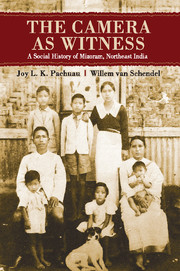Book contents
- Frontmatter
- Contents
- List of Figures
- List of Maps
- Acknowledgements
- I Becoming Mizo
- II Mizoram in the New India
- III Visions of Independence
- 17 Famine and Revolt
- 18 The Mizoram Government at Home and in East Pakistan
- 19 The Mizoram Government in Burma, China and Bangladesh
- 20 A State and its Minorities
- IV Mizo Modernities
- Copyrights and Sources
- Glossary
- Bibliography
- Index
18 - The Mizoram Government at Home and in East Pakistan
from III - Visions of Independence
Published online by Cambridge University Press: 05 May 2015
- Frontmatter
- Contents
- List of Figures
- List of Maps
- Acknowledgements
- I Becoming Mizo
- II Mizoram in the New India
- III Visions of Independence
- 17 Famine and Revolt
- 18 The Mizoram Government at Home and in East Pakistan
- 19 The Mizoram Government in Burma, China and Bangladesh
- 20 A State and its Minorities
- IV Mizo Modernities
- Copyrights and Sources
- Glossary
- Bibliography
- Index
Summary
The revolt of the sovereign Mizoram Government (Mizoram Sawrkar) – as the Mizo National Front now styled itself – was followed by days of confusion. Then the Indian army retaliated, forcing the Mizoram Government to go underground. The Indian armed forces retook the towns but they were unable to control the countryside – hence the draconian resettlement operations to restrain the population (Chapter 17). Even these failed to blow the Mizoram Government's cover, however: it continued to operate from forest hideouts. The military wing of the government, the Mizo National Army (MNA), consisted of eight battalions. The first four – Chawngbawla, Khuangchera, Saizahawla and Taitesena – formed the Lion Brigade, which operated in the northern half of Mizoram, and the other four – Joshua, Lalvunga, Vanapa and Zampui Manga – formed the Dagger Brigade, operating in the south. The Mizo National Volunteers (MNV) supported them. The insurgents were keen to document their existence, and we have numerous photographs in which administrators, medical personnel, fighters and political leaders present themselves to the camera. Many of these images are damaged because they shared an underground experience with the people they depict.
The Mizoram government underground, 1966–1969
It was relatively easy for the rebel government to ensconce itself in the Mizoram countryside. Many of its fighters were ex-servicemen who knew the difficult terrain. Some had served in the Chin Rifles of the Burmese Army, others in the Indian Army or the Assam Rifles. ‘[A] large-scale dismissal of mutinous Mizo jawans [soldiers] serving in an Assam Regiment in Kashmir in 1954, prompted by the non-availability of their staple diet, rice, and the harsh treatment meted out to them by North Indian officers, had swelled the ranks of the MNF’. 3 Furthermore, they had built up their tactical skills from the early 1960s, when leaders and volunteers had been visiting neighbouring East Pakistan and getting arms and training from the Pakistan army – about which more later.
- Type
- Chapter
- Information
- The Camera as WitnessA Social History of Mizoram, Northeast India, pp. 318 - 340Publisher: Cambridge University PressPrint publication year: 2015

